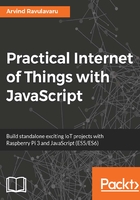
Conventions
In this book, you will find a number of text styles that distinguish between different kinds of information. Here are some examples of these styles and an explanation of their meaning. Code words in text, database table names, folder names, filenames, file extensions, pathnames, dummy URLs, user input, and Twitter handles are shown as follows: "Now, inside the broker folder, create another folder named certs and cd into that folder." A block of code is set as follows:
// MongoDB connection options
mongo: {
uri: 'mongodb://admin:admin123@ds241055.mlab.com:41055/iotfwjs'
},
mqtt: {
host: process.env.EMQTT_HOST || '127.0.0.1',
clientId: 'API_Server_Dev',
port: 8883
}
};
Any command-line input or output is written as follows:
openssl req -newkey rsa:2048 -nodes -keyout key.pem -x509 -days 365 -out certificate.pem
New terms and important words are shown in bold. Words that you see on the screen, for example, in menus or dialog boxes, appear in the text like this: "Once logged in, click on the Create New button to create a new DB."
Warnings or important notes appear like this.
Tips and tricks appear like this.